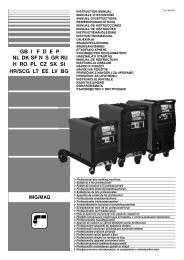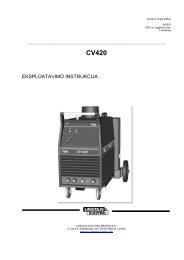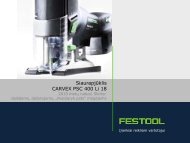MANUALE ISTRUZIONE - Jula
MANUALE ISTRUZIONE - Jula
MANUALE ISTRUZIONE - Jula
You also want an ePaper? Increase the reach of your titles
YUMPU automatically turns print PDFs into web optimized ePapers that Google loves.
When the torch is brought close to the piece to be cut, which is connected outside surfaces. If the hole is larger than the original diameter or if it is<br />
to the (+) polarity of the power source, the pilot arc is transferred to set up deformed, change the nozzle. If the surfaces are particularly oxidized<br />
a plasma arc between the electrode (-) and the piece itself (the cutting clean them with very fine abrasive paper.<br />
arc):<br />
4- Air distribution ring.<br />
The pilot arc is disabled as soon as the plasma arc is established Make sure there are no burns or cracks and that the air passage holes<br />
between the electrode and the piece.<br />
are not blocked. If damaged, change the ring immediately.<br />
Pilot arc hold time is set in the factory at 2 s; if there is no arc transfer 5- Electrode.<br />
within this time the cycle is automatically stopped, apart from the Change the electrode when the depth of the crater formed on the<br />
continuance of cooling air.<br />
emitter surface is approx. 1.5 mm (FIG. O).<br />
To re-start the cycle it is necessary to release the torch button and then 6- Torch body, handgrip and cable.<br />
press it again.<br />
These components do not normally need any particular maintenance<br />
apart from regular inspection and careful cleaning without using any<br />
Preliminary operations.<br />
kind of solvent. If the insulation is damaged, with breakages, cracks or<br />
Before starting cutting operations, make sure the consumable parts have burns etc., or if the electric leads are loose, the torch may not be used<br />
been fitted correctly by inspecting the head of the torch, as described in because it does not satisfy safety requirements.<br />
the chapter on "TORCH MAINTENANCE".<br />
In this case repairs (extraordinary maintenance) cannot be done on<br />
- Switch on the power source and set the cutting current (FIG. C-1), the spot and the torch must be sent to an authorised service centre,<br />
basing it on the thickness and type of the metal that is to be cut. TAB. 3 which will be able to carry out the special tests needed after the repair<br />
shows the cutting rate for various thicknesses of aluminium, iron and has been done.<br />
steel.<br />
In order to keep the torch and cable in good working order, take the<br />
- Press and release the torch button so that there is an outflow of air ( following precautions:<br />
³30 seconds of post-air). - do not allow the torch and cable to come into contact with hot or redhot<br />
- During this period, adjust the air pressure until the reading on the<br />
parts.<br />
pressure gauge corresponds to the required value in “bar” for the - do not pull the cable hard.<br />
particular torch being used (TAB. 2).<br />
- do not pass the cable over pointed or sharp edges or over abrasive<br />
- Operate the air button so that the air flows out of the torch.<br />
surfaces.<br />
- Adjust the knob: pull upwards to release it and turn it to adjust the - wind the cable into regular loops if it is longer than needed.<br />
pressure to the value given in the TECHNICAL INFORMATION - do not pass over the cable with any vehicle and do not stand on it.<br />
ABOUT THE TORCH.<br />
Warning.<br />
- When the required reading (bar) is shown on the pressure gauge, - Before carrying out any work on the torch leave it to cool for at least the<br />
press the knob to lock the pressure at the adjusted value.<br />
complete “post air" time<br />
- Allow the last air to flow out naturally in order to facilitate removal of any - Except in special cases, we recommend changing the electrode and<br />
condensation that may have formed inside the torch.<br />
nozzle at the same time.<br />
Important:<br />
- Assemble the torch components in the correct order (the reverse of the<br />
- Contact cut (with torch nozzle in contact with piece being cut): this can order for dismantling).<br />
be applied with a max current of 40-50A (higher current values will - Make sure that the distributor ring is fitted the right way round.<br />
immediately destroy the nozzle-electrode-nozzle holder).<br />
- When re-assembling the nozzle holder, screw it down manually, forcing<br />
- Space cutting (with a spacer mounted on the torch, FIG. I): this can be it slightly.<br />
applied for currents of over 35A;<br />
- Never ever fit the nozzle holder before you assemble the electrode,<br />
- Extended nozzle and electrode: this can be applied where provided distributor ring and nozzle.<br />
for.<br />
- Do not keep the pilot arc struck in air for no reason as this will increase<br />
electrode, diffuser and nozzle wear.<br />
Cutting operations (FIG. L).<br />
- Do not tighten the electrode too much as this could damage the torch.<br />
- Bring the torch nozzle close to the edge of the piece (at about 2 mm), - Prompt, correct inspection procedures for the consumable parts of the<br />
press the torch button; after about 1 second (pre-air) the pilot arc will torch are essential for safe, correct operation of the cutting system.<br />
strike.<br />
- If the insulation is damaged, with breakages, cracks or burns etc., or if<br />
- If the distance is right the pilot arc will immediately transfer to the piece, the electric leads are loose, the torch may not be used because it does<br />
causing the cutting arc to strike.<br />
not satisfy safety requirements. In this case repairs (extraordinary<br />
- Move the torch at a constant rate over the surface of the piece along maintenance) cannot be done on the spot and the torch must be sent to<br />
the ideal cutting line.<br />
an authorised service centre, which will be able to carry out the special<br />
- Adjust the cutting rate according to the thickness and the selected tests needed after the repair has been done.<br />
current, making sure that the arc comes out of the lower surface of the<br />
piece at an inclination of 5-10° to the vertical in the opposite direction Compressed air filter<br />
to the cutting direction.<br />
- The filter is designed for automatic condensation drainage whenever it<br />
- If the torch and piece are too far apart or if there is no material (end of is disconnected from the compressed air line.<br />
cut) the arc will immediately be cut off.<br />
- Inspect the filter regularly; if there is water in the glass it can be drained<br />
- It is always possible to break the (cutting or pilot) arc by releasing the off manually by pushing the drain connector upwards.<br />
torch button.<br />
- If the filter cartridge is especially dirty it must be changed in order to<br />
prevent an excessive pressure loss.<br />
Drilling (FIG. M)<br />
When this operation is necessary, or to start cutting in the centre of the EXTRAORDINARY MAINTENANCE<br />
piece, strike the arc with an inclined torch and bring it gradually to a EXTRAORDINARY MAINTENANCE MUST BE CARRIED OUT ONLY<br />
vertical position.<br />
AND EXCLUSIVELY BY AUTHORISED EXPERT OR SKILLED<br />
- This procedure will stop arc returns or melted particles from damaging ELECTRICAL-MECHANICAL TECHNICIANS.<br />
-<br />
the nozzle hole and causing rapid wear.<br />
________________________________________________________<br />
It is possible to drill pieces directly when their thickness is below 25%<br />
of the maximum allowed range. WARNING! BEFORE REMOVING THE MACHINE PANELS AND<br />
7. MAINTENANCE<br />
WORKING INSIDE IT MAKE SURE THAT IT HAS BEEN SWITCHED<br />
________________________________________________________ OFF AND DISCONNECTED FROM THE MAIN POWER SUPPLY.<br />
If checks are carried out inside the machine while it is live, this may<br />
cause serious electric shock due to direct contact with live parts.<br />
WARNING! BEFORE CARRYING OUT MAINTENANCE<br />
________________________________________________________<br />
OPERATIONS, MAKE SURE THAT THE PLASMA CUTTING SYSTEM - Inspect the inside of the machine regularly, with a frequency depending<br />
IS SWITCHED OFF AND DISCONNECTED FROM THE MAIN POWER on the amount of use and dust in the environment, and remove dust<br />
SUPPLY.<br />
that has deposited on the transformer, rectifier, inductance and<br />
________________________________________________________ resistors, using a jet of dry compressed air (max 10 bar).<br />
- Do not direct the jet of compressed air onto the electronic boards; these<br />
ROUTINE MAINTENANCE<br />
can be cleaned with a very soft brush or suitable solvents.<br />
ROUTINE MAINTENANCE CAN BE CARRIED OUT BY THE - Take the opportunity to make sure the electrical connections are tight<br />
OPERATOR.<br />
and there is no damage to the wiring insulation.<br />
- Make sure the compressed air circuit hoses and connections are intact<br />
TORCH (FIG. N)<br />
and leak-free.<br />
Depending on the amount of use, make regular checks on the wear of the - When these operations have been completed, re-assemble the panels<br />
parts of the torch concerned with the plasma arc and proceed likewise if on the machine and tighten the fastening screws right down.<br />
cutting defects are noted.<br />
- Never ever carry out cutting operations with the machine open.<br />
1- Spacer.<br />
Change it if it is so deformed or covered with slag that it is impossible to 8. TROUBLESHOOTING<br />
maintain the correct position of the torch (distance and IN THE CASE OF UNSATISFACTORY OPERATION, AND BEFORE<br />
perpendicularity).<br />
CARRYING OUT MORE SYSTEMATIC TESTS OR CONTACTING<br />
2- Nozzle holder.<br />
YOUR SERVICING CENTRE CARRY OUT THE FOLLOWING<br />
Unscrew it manually from the head of the torch. Clean it carefully or CHECKS:<br />
change it if it is damaged (burnt, deformed or cracked). Make sure the - Check whether the yellow LED is ON, indicating triggering of the<br />
top metal section is intact (torch safety rocker).<br />
thermal cutout, over- or under-voltage or shorting.<br />
3- Nozzle.<br />
- Make sure that the nominal duty cycle has been respected; if the<br />
Check for wear on the plasma arch passage hole and on the inside and thermal cutout triggers, wait until the machine cools down naturally<br />
- 7 -







